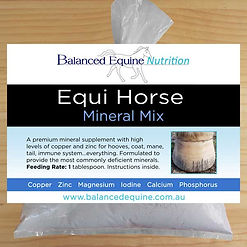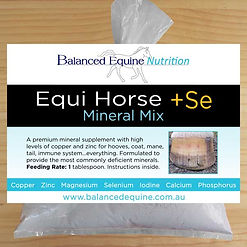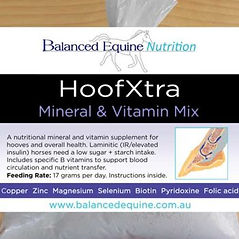Stringhalt: What to feed
from a nutritional aspect. It can be devastating to discover your horse moving oddly, with the classic leg jerking.
Stringhalt (the Australian variety) is caused by horses grazing Flatweed (Hypochoeris radicata) though Dandelion is also implicated. It’s been theorised that a fungus associated with these plants causes damage to the peripheral nervous system but the mechanism is not clear how this happens. More recent research by MacKay et al looked at a possible toxin in the plant itself. The most obvious nerve affected is the sciatic nerve, which is the longest peripheral nerve in the horse and causes the classic leg jerking. Other nerves may also be affected, including the optic nerve, resulting in impaired vision. Depending on the severity of damage, the sciatic nerve can take approximately two years to regrow, so symptoms may persist for that length of time.
Number ONE: Consult your vet as diagnosis is vital. Your horse may need veterinary prescribed medication to prevent permanent damage.
What to feed:
-
First step, in consultation with your vet is to remove the horse from the cause, the pasture that contains the plants that are causing Stringhalt. This is the only remedy that will prevent Stringhalt.
-
Best approach as for any horse, of any category, whether Stringhalt affected or not is to feed a mineral balanced intake based on data (pasture or hay test, whichever is appropriate). Whether testing is possible or not, the diet should be as high in fibre as possible, 2 tablespoons of salt along with a quality mineral mix, for example Equi Horse +Se.
-
Often magnesium is recommended to help prevent stringhalt (for example, dolomite, an inefficient magnesium source). A magnesium deficiency can produce muscle irritability, twitchiness as symptoms but magnesium is not a cause of Stringhalt or a cure. Horses outside of known Stringhalt plant areas do not develop Stringhalt. Some people say that all of Australia's grazing country is deficient in magnesium, this is not correct, it varies. Most of the pasture and hay tests I see for parts of Australia don't indicate magnesium as too low for horses though a small amount of additional magnesium can be helpful for optimising the calcium to magnesium ratio. One of the most important functions of magnesium is to control the movement of calcium along calcium channels which forms the basis for all ‘excitable’ tissue activity, including the nervous system, heart, skeletal muscle and smooth muscle in the intestinal tract, uterus, urinary tract and blood vessels. Magnesium controls the sensitivity of the calcium channel, and is also required for the production and storage of the ATP (energy) that is needed by the sodium-potassium pumps to do their job of clearing the calcium from the cell and put it back into storage sites. The symptoms of inadequate magnesium are the same as those of excessive ionised calcium. (NRCPlus, drkellon.com).
-
A horse with Stringhalt AND a magnesium deficiency can at least be helped with additional magnesium but very important to understand, magnesium is not a cure or preventative for Stringhalt. Equi Horse, Equi Horse +Se and HoofXtra contain magnesium.
-
Thiamine, vitamin B1 has been theorised to be able to help. An example of one of the highest natural sources is Brewer's yeast (can be around 95.2 mg/kg).
-
Vitamin E is an important antioxidant which may help.
Interesting stuff about Stringhalt:
-
There are two types defined as Stringhalt. One is a physical clinical condition characterised by extreme, exaggerated flexion of the hindlimbs due to trauma, sometimes called classical Stringhalt. The other is called Australian Stringhalt, associated with the grazing of certain plants, including Hypochaeris radicata.
-
Hypochaeris radicata Flatweed
-
-
Horses can be diagnosed with either type of Stringhalt, either caused by trauma to nerves or the extensor tendon in the hindlimbs OR from grazing pasture that has plants that cause Australian Stringhalt.
-
In this study it was found that plant toxins can become concentrated in plants under stress. Stringhalt outbreaks are associated with pasture that has had periods of drought and overgrazing, and in pasture that is lacking fertility.
-
Australian Stringhalt has been diagnosed in horses not only in Australia but also in New Zealand and parts of Europe.
-
Researchers have used the medication phenytoin to treat horses with Stringhalt, see links below. There are other medications, consult your vet for best treatment.
Will a toxin binder prevent Australian Stringhalt?
Unfortunately there is no evidence that supports toxin binders as an effective preventative.
From the RIRDC Investigation into the Cause of Australian Stringhalt “Horse owners are often advised to feed a variety of supplements to treat or prevent stringhalt. Mycotoxin binders are not uncommonly recommended (author’s observations). Our findings suggest that the practice of feeding mycotoxin (fungal toxin) binders may be unlikely to protect horses from developing AS.” Link below.
Further reading:
Links may change over time. If a link doesn’t work, search the title in your search engine.
Domange C, Casteignau A, Collignon G, Pumarola M, Priymenko N (2010) Longitudinal study of Australian Stringhalt cases in France
https://www.ncbi.nlm.nih.gov/pubmed/20662969
El-Hage C (2011) Investigation into the Cause of Australian Stringhalt, RIRDC Publication No 11/127
https://www.agrifutures.com.au/wp-content/uploads/publications/11-127.pdf
Huntington PJ, Jeffcott LB, Friend SC, Luff AR, Finkelstein DK, Flynn RJ (1989) Australian Stringhalt – epidemiological, clinical and neurological investigations
https://www.ncbi.nlm.nih.gov/pubmed/2767028
Huntington PJ, Seneque S, Slocombe RF, Jeffcott LB, McLean A, Luff AR (1991) Use of phenytoin to treat horses with Australian Stringhalt
https://www.ncbi.nlm.nih.gov/pubmed/1929987
MacKay RJ, Wyer S, Gilmour A, Kongara K, Harding DR, Clark S, Mayhew IG, Thomson CE (2013) Cytotoxic activity of extracts from Hypochaeris radicata
https://www.sciencedirect.com/science/article/pii/S0041010113001803
Slocombe RF, Huntington PJ, Friend SC, Jeffcott LB, Luff AR, Finkelstein DK (1992) Pathological aspects of Australian Stringhalt
https://www.ncbi.nlm.nih.gov/pubmed/1606929
Image of Flatweed sourced from WA FloraBase









